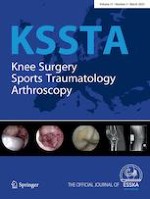Published in:

21-10-2021 | KNEE
Aseptic revision total knee arthroplasty outcomes were equivalent to patients’ own pre-failure state but inferior to patients without revision
Authors:
Yong Zhi Khow, Ming Han Lincoln Liow, Graham S. Goh, Jerry Yongqiang Chen, Ngai Nung Lo, Seng Jin Yeo
Published in:
Knee Surgery, Sports Traumatology, Arthroscopy
|
Issue 3/2023
Login to get access
Abstract
Purpose
The purpose of this study was to (1) longitudinally compare the patient-reported outcome measures (PROMs) of the same patients who underwent primary TKA and revision TKA, and (2) compared the results of these revision TKA with a matched cohort of well-functioning primary TKA. The hypothesis was revision TKA could result in equivalent outcomes to patients’ own primary TKA or the primary TKA of patients who did not require revision.
Methods
Prospectively collected data of 123 patients who underwent primary TKA and subsequently aseptic revision TKA (“revised group”), were matched using nearest-neighbor method to 123 well-functioning primary TKA that did not require revision (“control group”). Preoperative (prior to primary TKA), at time of failure (prior to revision TKA), postoperative 6-month and 2-year PROMs included Knee Society scores (KSS), Oxford Knee Score (OKS) and Short Form-36 (SF-36). Minimal clinically important difference (MCID) attainment was analyzed. Wilcoxon and McNemar’s tests were used to compare outcomes within the revised group (primary vs revision), Mann–Whitney U test and Chi-Square test for the revised and control groups.
Results
The revised group had poorer KSS objective (p = 0.045), KSS functional (p < 0.001), OKS (p = 0.011) and SF-36 PCS (p < 0.001) at time of failure (prior to revision TKA), compared to their preoperative PROMs (prior to primary TKA). Revision TKA resulted in restoration of KSS objective, OKS and SF-36 PCS (NS) that were equivalent to their primary TKA, but poorer KSS functional (p < 0.050). Patients in the revised group had a lower proportion of MCID attainment in KSS objective (p = 0.014) and OKS (p < 0.001) at 2-year after primary TKA when compared to the control group. Revision TKA also led to poorer KSS objective, KSS functional and SF-36 PCS (p < 0.050) when compared to primary TKA of the control group.
Conclusion
Outcomes following aseptic revision were equivalent to patients' own pre-failure state but inferior to patients with non-revised implants. An individualized approach toward goal setting and assessing adequacy of aseptic revision TKA can be adopted based on patients’ pre-failure outcomes.





